Analyzing Tesco PLC with Demand-Supply and Economic Theories
VerifiedAdded on 2023/06/15
|12
|3109
|59
Report
AI Summary
This report provides an analysis of Tesco PLC through the lens of microeconomic principles, focusing on the laws of demand and supply and their impact on the company's strategies. It examines how changes in price, consumer income, tastes, advertising, and future price expectations affect the demand curve for Tesco's products. The report also discusses the law of supply, detailing how Tesco's supply decisions respond to price changes and various factors such as the number of suppliers, resource prices, taxes, subsidies, and technology. Furthermore, the report contrasts emerging economic theories with those of the 20th century, highlighting the shift from political to scientific perspectives and discussing the role of aggregate demand, full employment, and market dynamics in contemporary business economics. The document is contributed by a student and available on Desklib, a platform offering study tools and resources for students.
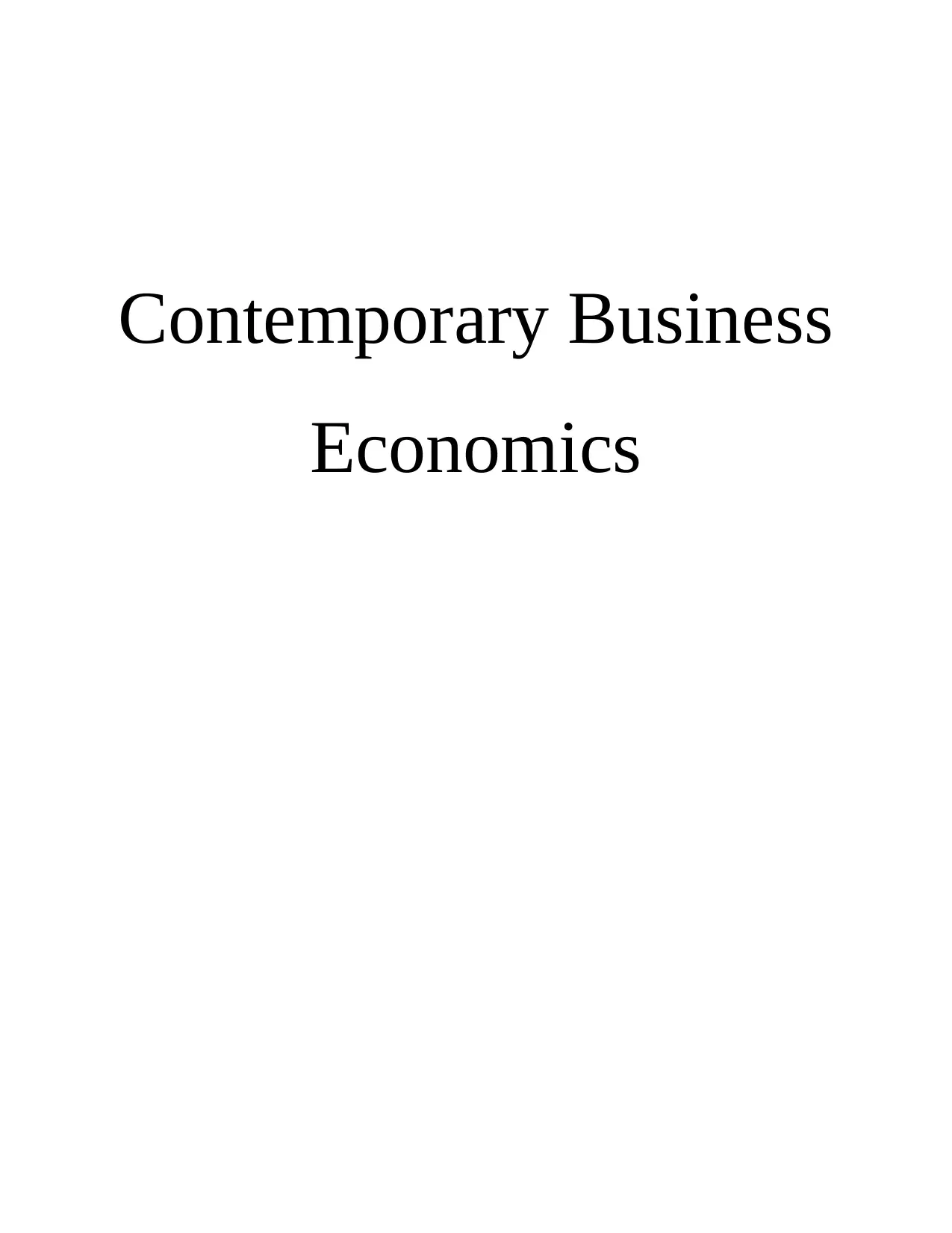
Contemporary Business
Economics
Economics
Paraphrase This Document
Need a fresh take? Get an instant paraphrase of this document with our AI Paraphraser
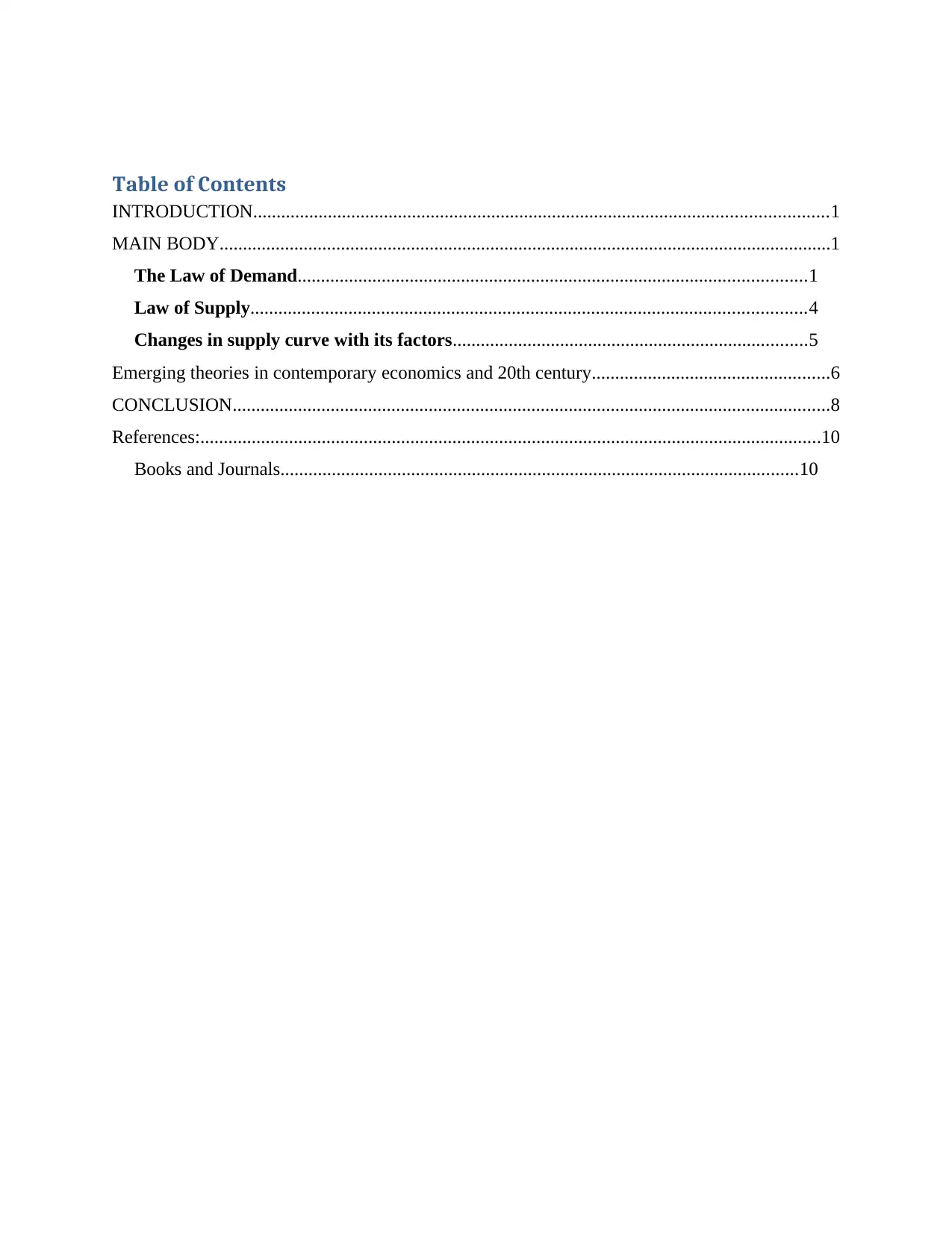
Table of Contents
INTRODUCTION...........................................................................................................................1
MAIN BODY...................................................................................................................................1
The Law of Demand.............................................................................................................1
Law of Supply.......................................................................................................................4
Changes in supply curve with its factors............................................................................5
Emerging theories in contemporary economics and 20th century...................................................6
CONCLUSION................................................................................................................................8
References:.....................................................................................................................................10
Books and Journals...............................................................................................................10
INTRODUCTION...........................................................................................................................1
MAIN BODY...................................................................................................................................1
The Law of Demand.............................................................................................................1
Law of Supply.......................................................................................................................4
Changes in supply curve with its factors............................................................................5
Emerging theories in contemporary economics and 20th century...................................................6
CONCLUSION................................................................................................................................8
References:.....................................................................................................................................10
Books and Journals...............................................................................................................10
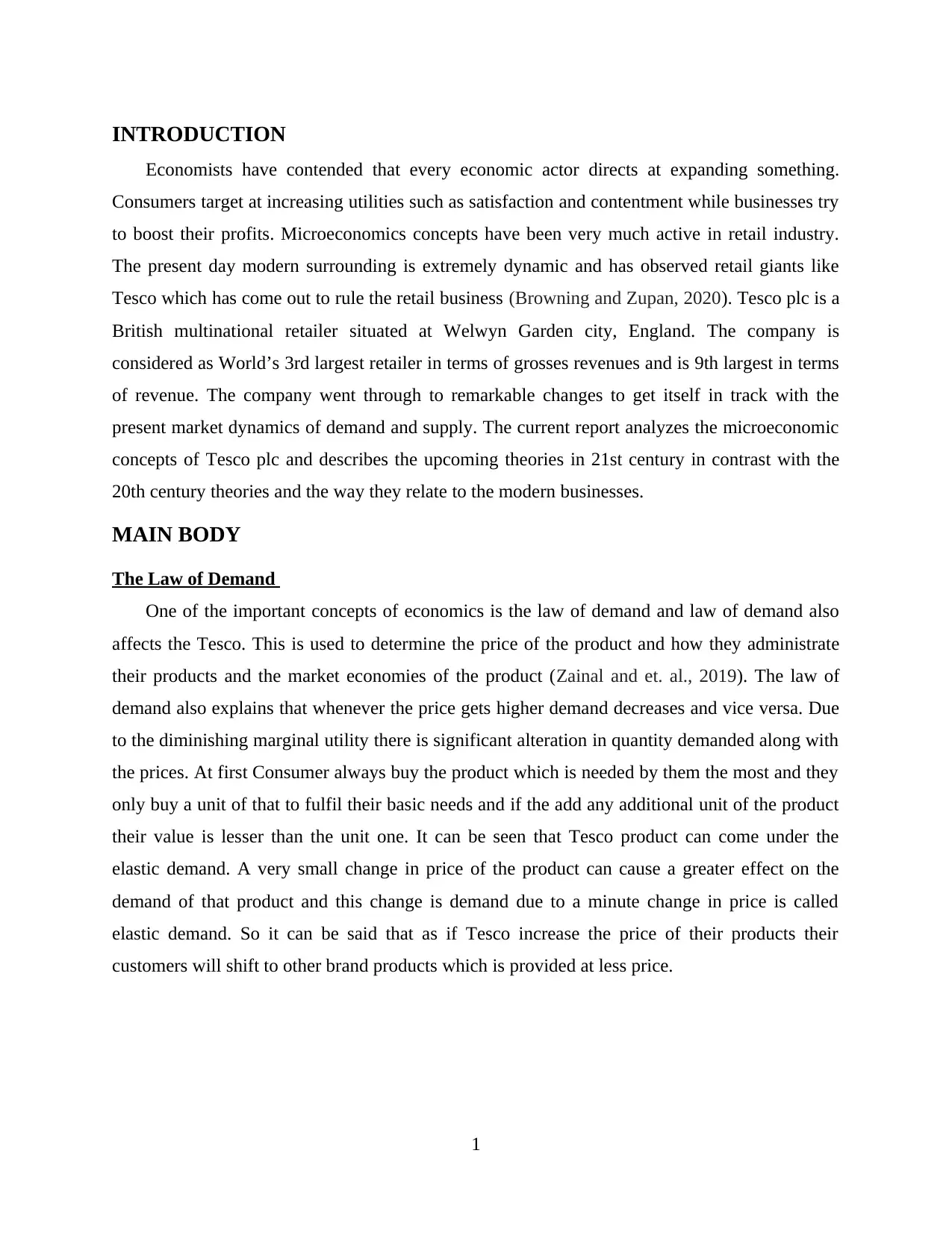
INTRODUCTION
Economists have contended that every economic actor directs at expanding something.
Consumers target at increasing utilities such as satisfaction and contentment while businesses try
to boost their profits. Microeconomics concepts have been very much active in retail industry.
The present day modern surrounding is extremely dynamic and has observed retail giants like
Tesco which has come out to rule the retail business (Browning and Zupan, 2020). Tesco plc is a
British multinational retailer situated at Welwyn Garden city, England. The company is
considered as World’s 3rd largest retailer in terms of grosses revenues and is 9th largest in terms
of revenue. The company went through to remarkable changes to get itself in track with the
present market dynamics of demand and supply. The current report analyzes the microeconomic
concepts of Tesco plc and describes the upcoming theories in 21st century in contrast with the
20th century theories and the way they relate to the modern businesses.
MAIN BODY
The Law of Demand
One of the important concepts of economics is the law of demand and law of demand also
affects the Tesco. This is used to determine the price of the product and how they administrate
their products and the market economies of the product (Zainal and et. al., 2019). The law of
demand also explains that whenever the price gets higher demand decreases and vice versa. Due
to the diminishing marginal utility there is significant alteration in quantity demanded along with
the prices. At first Consumer always buy the product which is needed by them the most and they
only buy a unit of that to fulfil their basic needs and if the add any additional unit of the product
their value is lesser than the unit one. It can be seen that Tesco product can come under the
elastic demand. A very small change in price of the product can cause a greater effect on the
demand of that product and this change is demand due to a minute change in price is called
elastic demand. So it can be said that as if Tesco increase the price of their products their
customers will shift to other brand products which is provided at less price.
1
Economists have contended that every economic actor directs at expanding something.
Consumers target at increasing utilities such as satisfaction and contentment while businesses try
to boost their profits. Microeconomics concepts have been very much active in retail industry.
The present day modern surrounding is extremely dynamic and has observed retail giants like
Tesco which has come out to rule the retail business (Browning and Zupan, 2020). Tesco plc is a
British multinational retailer situated at Welwyn Garden city, England. The company is
considered as World’s 3rd largest retailer in terms of grosses revenues and is 9th largest in terms
of revenue. The company went through to remarkable changes to get itself in track with the
present market dynamics of demand and supply. The current report analyzes the microeconomic
concepts of Tesco plc and describes the upcoming theories in 21st century in contrast with the
20th century theories and the way they relate to the modern businesses.
MAIN BODY
The Law of Demand
One of the important concepts of economics is the law of demand and law of demand also
affects the Tesco. This is used to determine the price of the product and how they administrate
their products and the market economies of the product (Zainal and et. al., 2019). The law of
demand also explains that whenever the price gets higher demand decreases and vice versa. Due
to the diminishing marginal utility there is significant alteration in quantity demanded along with
the prices. At first Consumer always buy the product which is needed by them the most and they
only buy a unit of that to fulfil their basic needs and if the add any additional unit of the product
their value is lesser than the unit one. It can be seen that Tesco product can come under the
elastic demand. A very small change in price of the product can cause a greater effect on the
demand of that product and this change is demand due to a minute change in price is called
elastic demand. So it can be said that as if Tesco increase the price of their products their
customers will shift to other brand products which is provided at less price.
1
⊘ This is a preview!⊘
Do you want full access?
Subscribe today to unlock all pages.

Trusted by 1+ million students worldwide
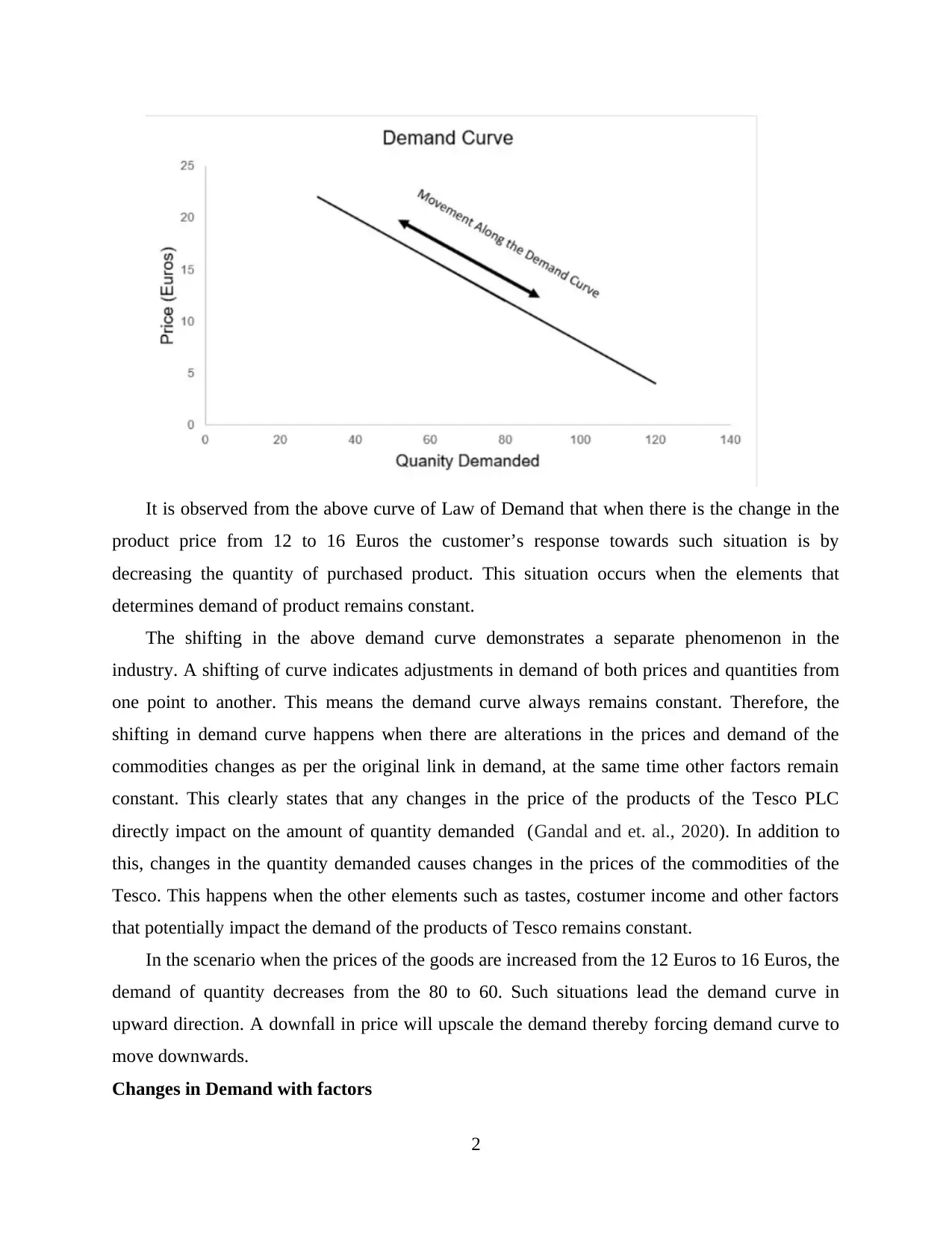
It is observed from the above curve of Law of Demand that when there is the change in the
product price from 12 to 16 Euros the customer’s response towards such situation is by
decreasing the quantity of purchased product. This situation occurs when the elements that
determines demand of product remains constant.
The shifting in the above demand curve demonstrates a separate phenomenon in the
industry. A shifting of curve indicates adjustments in demand of both prices and quantities from
one point to another. This means the demand curve always remains constant. Therefore, the
shifting in demand curve happens when there are alterations in the prices and demand of the
commodities changes as per the original link in demand, at the same time other factors remain
constant. This clearly states that any changes in the price of the products of the Tesco PLC
directly impact on the amount of quantity demanded (Gandal and et. al., 2020). In addition to
this, changes in the quantity demanded causes changes in the prices of the commodities of the
Tesco. This happens when the other elements such as tastes, costumer income and other factors
that potentially impact the demand of the products of Tesco remains constant.
In the scenario when the prices of the goods are increased from the 12 Euros to 16 Euros, the
demand of quantity decreases from the 80 to 60. Such situations lead the demand curve in
upward direction. A downfall in price will upscale the demand thereby forcing demand curve to
move downwards.
Changes in Demand with factors
2
product price from 12 to 16 Euros the customer’s response towards such situation is by
decreasing the quantity of purchased product. This situation occurs when the elements that
determines demand of product remains constant.
The shifting in the above demand curve demonstrates a separate phenomenon in the
industry. A shifting of curve indicates adjustments in demand of both prices and quantities from
one point to another. This means the demand curve always remains constant. Therefore, the
shifting in demand curve happens when there are alterations in the prices and demand of the
commodities changes as per the original link in demand, at the same time other factors remain
constant. This clearly states that any changes in the price of the products of the Tesco PLC
directly impact on the amount of quantity demanded (Gandal and et. al., 2020). In addition to
this, changes in the quantity demanded causes changes in the prices of the commodities of the
Tesco. This happens when the other elements such as tastes, costumer income and other factors
that potentially impact the demand of the products of Tesco remains constant.
In the scenario when the prices of the goods are increased from the 12 Euros to 16 Euros, the
demand of quantity decreases from the 80 to 60. Such situations lead the demand curve in
upward direction. A downfall in price will upscale the demand thereby forcing demand curve to
move downwards.
Changes in Demand with factors
2
Paraphrase This Document
Need a fresh take? Get an instant paraphrase of this document with our AI Paraphraser
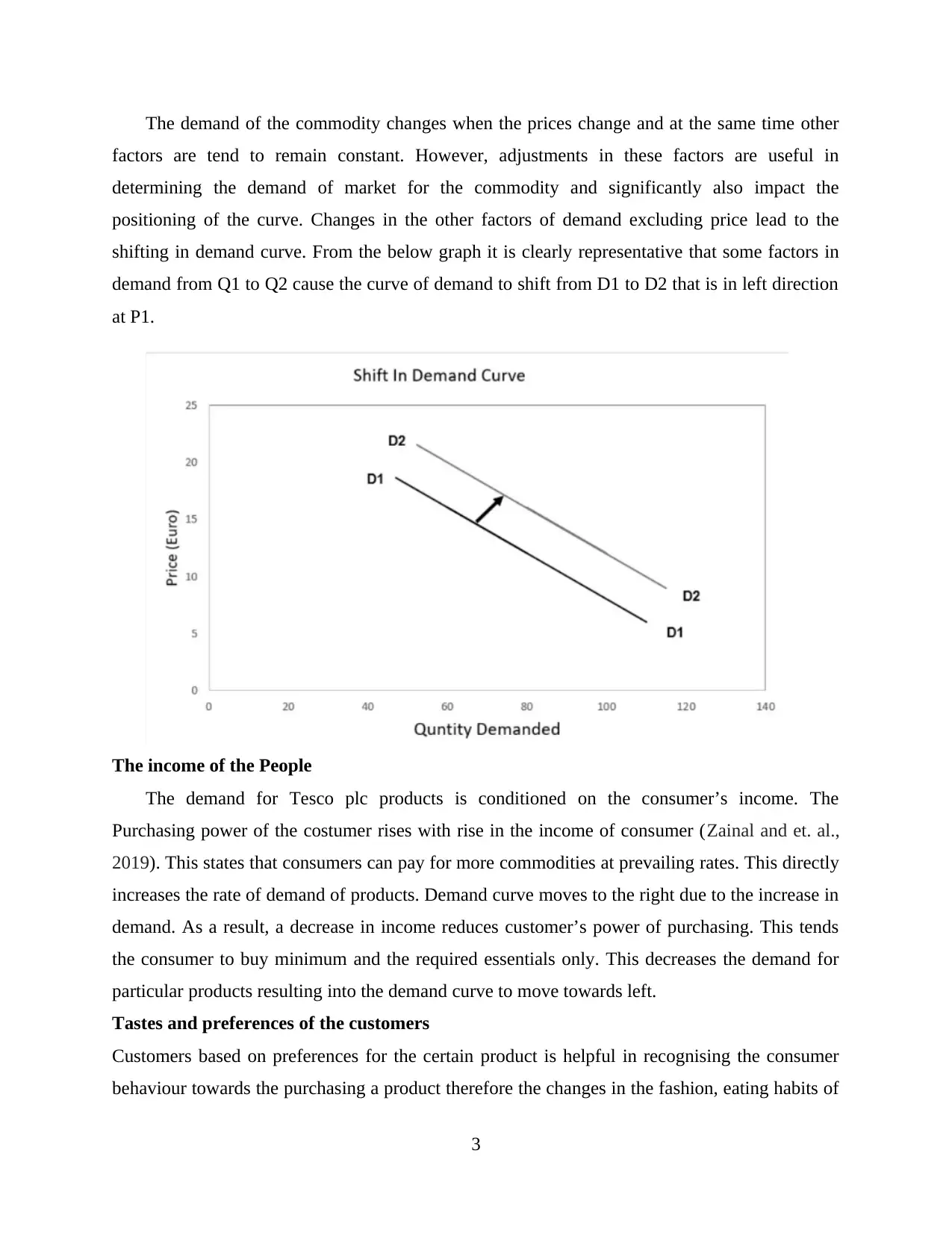
The demand of the commodity changes when the prices change and at the same time other
factors are tend to remain constant. However, adjustments in these factors are useful in
determining the demand of market for the commodity and significantly also impact the
positioning of the curve. Changes in the other factors of demand excluding price lead to the
shifting in demand curve. From the below graph it is clearly representative that some factors in
demand from Q1 to Q2 cause the curve of demand to shift from D1 to D2 that is in left direction
at P1.
The income of the People
The demand for Tesco plc products is conditioned on the consumer’s income. The
Purchasing power of the costumer rises with rise in the income of consumer (Zainal and et. al.,
2019). This states that consumers can pay for more commodities at prevailing rates. This directly
increases the rate of demand of products. Demand curve moves to the right due to the increase in
demand. As a result, a decrease in income reduces customer’s power of purchasing. This tends
the consumer to buy minimum and the required essentials only. This decreases the demand for
particular products resulting into the demand curve to move towards left.
Tastes and preferences of the customers
Customers based on preferences for the certain product is helpful in recognising the consumer
behaviour towards the purchasing a product therefore the changes in the fashion, eating habits of
3
factors are tend to remain constant. However, adjustments in these factors are useful in
determining the demand of market for the commodity and significantly also impact the
positioning of the curve. Changes in the other factors of demand excluding price lead to the
shifting in demand curve. From the below graph it is clearly representative that some factors in
demand from Q1 to Q2 cause the curve of demand to shift from D1 to D2 that is in left direction
at P1.
The income of the People
The demand for Tesco plc products is conditioned on the consumer’s income. The
Purchasing power of the costumer rises with rise in the income of consumer (Zainal and et. al.,
2019). This states that consumers can pay for more commodities at prevailing rates. This directly
increases the rate of demand of products. Demand curve moves to the right due to the increase in
demand. As a result, a decrease in income reduces customer’s power of purchasing. This tends
the consumer to buy minimum and the required essentials only. This decreases the demand for
particular products resulting into the demand curve to move towards left.
Tastes and preferences of the customers
Customers based on preferences for the certain product is helpful in recognising the consumer
behaviour towards the purchasing a product therefore the changes in the fashion, eating habits of
3
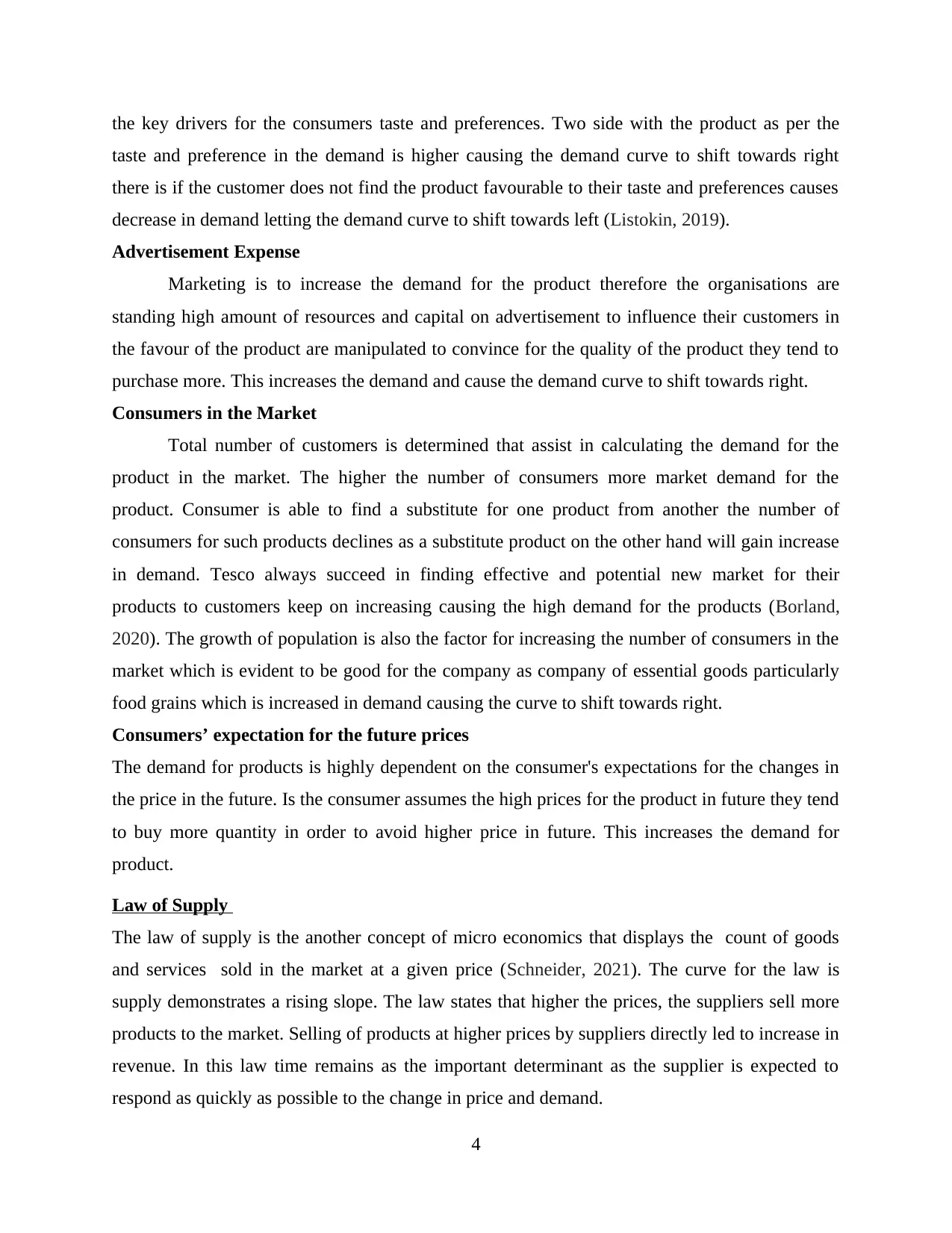
the key drivers for the consumers taste and preferences. Two side with the product as per the
taste and preference in the demand is higher causing the demand curve to shift towards right
there is if the customer does not find the product favourable to their taste and preferences causes
decrease in demand letting the demand curve to shift towards left (Listokin, 2019).
Advertisement Expense
Marketing is to increase the demand for the product therefore the organisations are
standing high amount of resources and capital on advertisement to influence their customers in
the favour of the product are manipulated to convince for the quality of the product they tend to
purchase more. This increases the demand and cause the demand curve to shift towards right.
Consumers in the Market
Total number of customers is determined that assist in calculating the demand for the
product in the market. The higher the number of consumers more market demand for the
product. Consumer is able to find a substitute for one product from another the number of
consumers for such products declines as a substitute product on the other hand will gain increase
in demand. Tesco always succeed in finding effective and potential new market for their
products to customers keep on increasing causing the high demand for the products (Borland,
2020). The growth of population is also the factor for increasing the number of consumers in the
market which is evident to be good for the company as company of essential goods particularly
food grains which is increased in demand causing the curve to shift towards right.
Consumers’ expectation for the future prices
The demand for products is highly dependent on the consumer's expectations for the changes in
the price in the future. Is the consumer assumes the high prices for the product in future they tend
to buy more quantity in order to avoid higher price in future. This increases the demand for
product.
Law of Supply
The law of supply is the another concept of micro economics that displays the count of goods
and services sold in the market at a given price (Schneider, 2021). The curve for the law is
supply demonstrates a rising slope. The law states that higher the prices, the suppliers sell more
products to the market. Selling of products at higher prices by suppliers directly led to increase in
revenue. In this law time remains as the important determinant as the supplier is expected to
respond as quickly as possible to the change in price and demand.
4
taste and preference in the demand is higher causing the demand curve to shift towards right
there is if the customer does not find the product favourable to their taste and preferences causes
decrease in demand letting the demand curve to shift towards left (Listokin, 2019).
Advertisement Expense
Marketing is to increase the demand for the product therefore the organisations are
standing high amount of resources and capital on advertisement to influence their customers in
the favour of the product are manipulated to convince for the quality of the product they tend to
purchase more. This increases the demand and cause the demand curve to shift towards right.
Consumers in the Market
Total number of customers is determined that assist in calculating the demand for the
product in the market. The higher the number of consumers more market demand for the
product. Consumer is able to find a substitute for one product from another the number of
consumers for such products declines as a substitute product on the other hand will gain increase
in demand. Tesco always succeed in finding effective and potential new market for their
products to customers keep on increasing causing the high demand for the products (Borland,
2020). The growth of population is also the factor for increasing the number of consumers in the
market which is evident to be good for the company as company of essential goods particularly
food grains which is increased in demand causing the curve to shift towards right.
Consumers’ expectation for the future prices
The demand for products is highly dependent on the consumer's expectations for the changes in
the price in the future. Is the consumer assumes the high prices for the product in future they tend
to buy more quantity in order to avoid higher price in future. This increases the demand for
product.
Law of Supply
The law of supply is the another concept of micro economics that displays the count of goods
and services sold in the market at a given price (Schneider, 2021). The curve for the law is
supply demonstrates a rising slope. The law states that higher the prices, the suppliers sell more
products to the market. Selling of products at higher prices by suppliers directly led to increase in
revenue. In this law time remains as the important determinant as the supplier is expected to
respond as quickly as possible to the change in price and demand.
4
⊘ This is a preview!⊘
Do you want full access?
Subscribe today to unlock all pages.

Trusted by 1+ million students worldwide
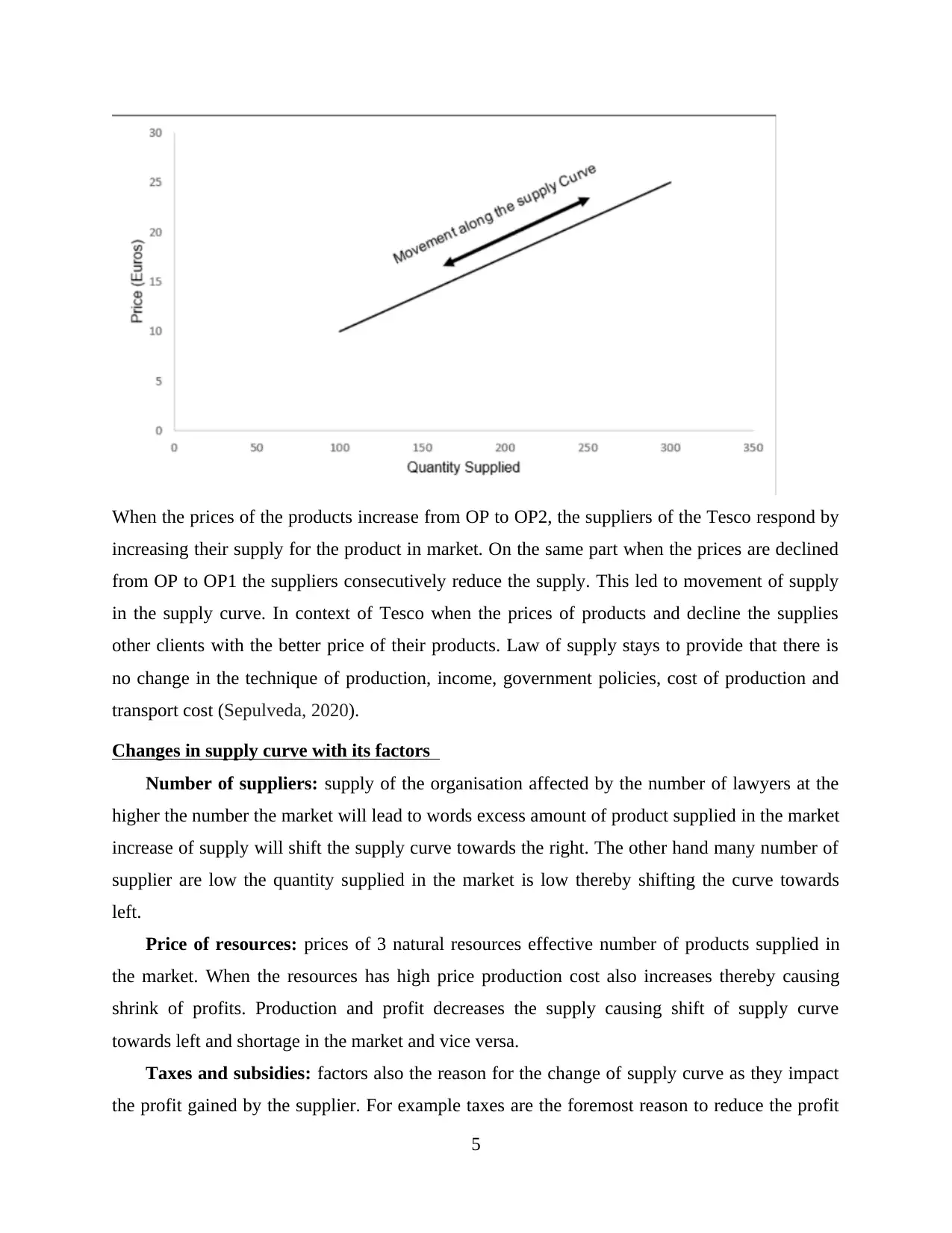
When the prices of the products increase from OP to OP2, the suppliers of the Tesco respond by
increasing their supply for the product in market. On the same part when the prices are declined
from OP to OP1 the suppliers consecutively reduce the supply. This led to movement of supply
in the supply curve. In context of Tesco when the prices of products and decline the supplies
other clients with the better price of their products. Law of supply stays to provide that there is
no change in the technique of production, income, government policies, cost of production and
transport cost (Sepulveda, 2020).
Changes in supply curve with its factors
Number of suppliers: supply of the organisation affected by the number of lawyers at the
higher the number the market will lead to words excess amount of product supplied in the market
increase of supply will shift the supply curve towards the right. The other hand many number of
supplier are low the quantity supplied in the market is low thereby shifting the curve towards
left.
Price of resources: prices of 3 natural resources effective number of products supplied in
the market. When the resources has high price production cost also increases thereby causing
shrink of profits. Production and profit decreases the supply causing shift of supply curve
towards left and shortage in the market and vice versa.
Taxes and subsidies: factors also the reason for the change of supply curve as they impact
the profit gained by the supplier. For example taxes are the foremost reason to reduce the profit
5
increasing their supply for the product in market. On the same part when the prices are declined
from OP to OP1 the suppliers consecutively reduce the supply. This led to movement of supply
in the supply curve. In context of Tesco when the prices of products and decline the supplies
other clients with the better price of their products. Law of supply stays to provide that there is
no change in the technique of production, income, government policies, cost of production and
transport cost (Sepulveda, 2020).
Changes in supply curve with its factors
Number of suppliers: supply of the organisation affected by the number of lawyers at the
higher the number the market will lead to words excess amount of product supplied in the market
increase of supply will shift the supply curve towards the right. The other hand many number of
supplier are low the quantity supplied in the market is low thereby shifting the curve towards
left.
Price of resources: prices of 3 natural resources effective number of products supplied in
the market. When the resources has high price production cost also increases thereby causing
shrink of profits. Production and profit decreases the supply causing shift of supply curve
towards left and shortage in the market and vice versa.
Taxes and subsidies: factors also the reason for the change of supply curve as they impact
the profit gained by the supplier. For example taxes are the foremost reason to reduce the profit
5
Paraphrase This Document
Need a fresh take? Get an instant paraphrase of this document with our AI Paraphraser
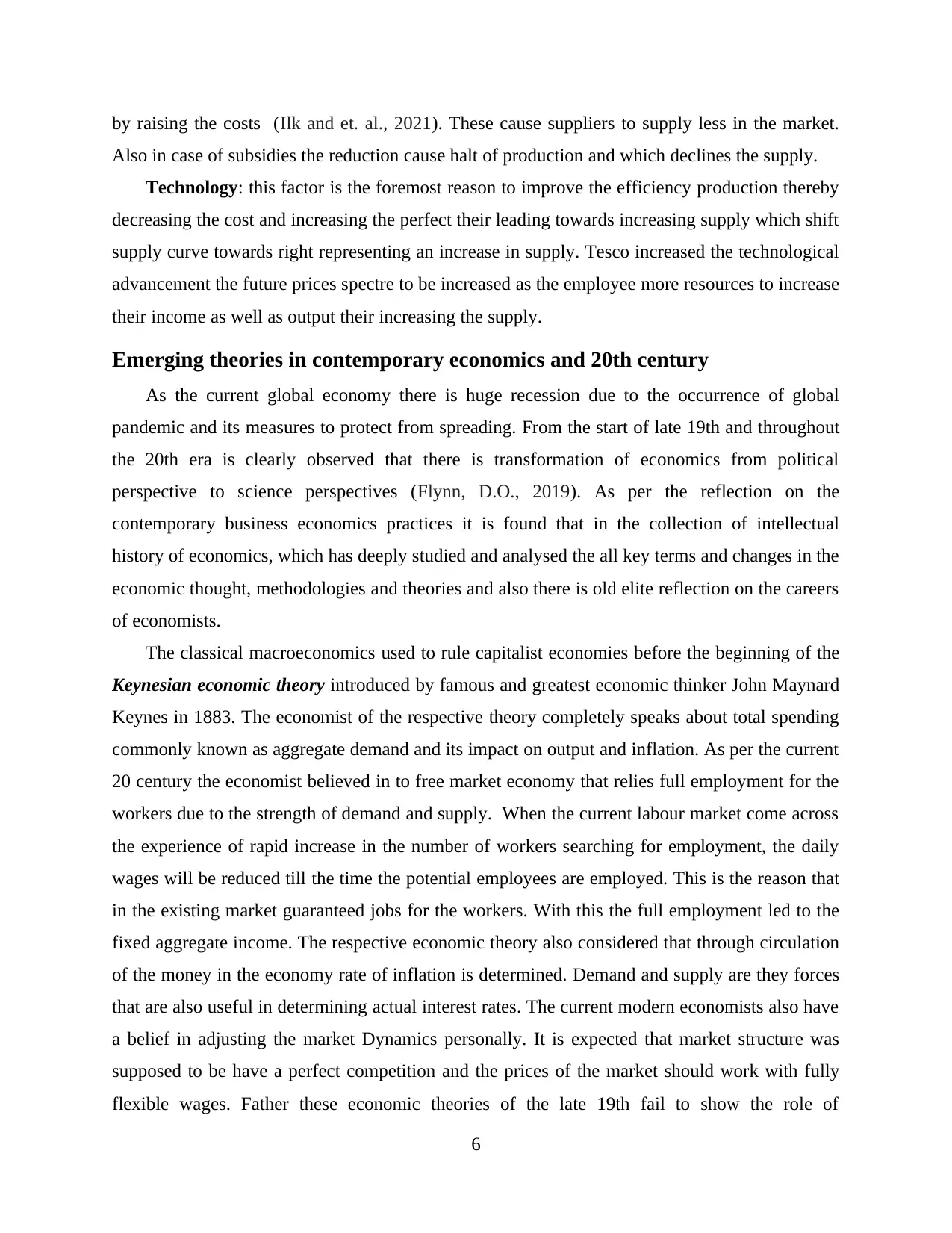
by raising the costs (Ilk and et. al., 2021). These cause suppliers to supply less in the market.
Also in case of subsidies the reduction cause halt of production and which declines the supply.
Technology: this factor is the foremost reason to improve the efficiency production thereby
decreasing the cost and increasing the perfect their leading towards increasing supply which shift
supply curve towards right representing an increase in supply. Tesco increased the technological
advancement the future prices spectre to be increased as the employee more resources to increase
their income as well as output their increasing the supply.
Emerging theories in contemporary economics and 20th century
As the current global economy there is huge recession due to the occurrence of global
pandemic and its measures to protect from spreading. From the start of late 19th and throughout
the 20th era is clearly observed that there is transformation of economics from political
perspective to science perspectives (Flynn, D.O., 2019). As per the reflection on the
contemporary business economics practices it is found that in the collection of intellectual
history of economics, which has deeply studied and analysed the all key terms and changes in the
economic thought, methodologies and theories and also there is old elite reflection on the careers
of economists.
The classical macroeconomics used to rule capitalist economies before the beginning of the
Keynesian economic theory introduced by famous and greatest economic thinker John Maynard
Keynes in 1883. The economist of the respective theory completely speaks about total spending
commonly known as aggregate demand and its impact on output and inflation. As per the current
20 century the economist believed in to free market economy that relies full employment for the
workers due to the strength of demand and supply. When the current labour market come across
the experience of rapid increase in the number of workers searching for employment, the daily
wages will be reduced till the time the potential employees are employed. This is the reason that
in the existing market guaranteed jobs for the workers. With this the full employment led to the
fixed aggregate income. The respective economic theory also considered that through circulation
of the money in the economy rate of inflation is determined. Demand and supply are they forces
that are also useful in determining actual interest rates. The current modern economists also have
a belief in adjusting the market Dynamics personally. It is expected that market structure was
supposed to be have a perfect competition and the prices of the market should work with fully
flexible wages. Father these economic theories of the late 19th fail to show the role of
6
Also in case of subsidies the reduction cause halt of production and which declines the supply.
Technology: this factor is the foremost reason to improve the efficiency production thereby
decreasing the cost and increasing the perfect their leading towards increasing supply which shift
supply curve towards right representing an increase in supply. Tesco increased the technological
advancement the future prices spectre to be increased as the employee more resources to increase
their income as well as output their increasing the supply.
Emerging theories in contemporary economics and 20th century
As the current global economy there is huge recession due to the occurrence of global
pandemic and its measures to protect from spreading. From the start of late 19th and throughout
the 20th era is clearly observed that there is transformation of economics from political
perspective to science perspectives (Flynn, D.O., 2019). As per the reflection on the
contemporary business economics practices it is found that in the collection of intellectual
history of economics, which has deeply studied and analysed the all key terms and changes in the
economic thought, methodologies and theories and also there is old elite reflection on the careers
of economists.
The classical macroeconomics used to rule capitalist economies before the beginning of the
Keynesian economic theory introduced by famous and greatest economic thinker John Maynard
Keynes in 1883. The economist of the respective theory completely speaks about total spending
commonly known as aggregate demand and its impact on output and inflation. As per the current
20 century the economist believed in to free market economy that relies full employment for the
workers due to the strength of demand and supply. When the current labour market come across
the experience of rapid increase in the number of workers searching for employment, the daily
wages will be reduced till the time the potential employees are employed. This is the reason that
in the existing market guaranteed jobs for the workers. With this the full employment led to the
fixed aggregate income. The respective economic theory also considered that through circulation
of the money in the economy rate of inflation is determined. Demand and supply are they forces
that are also useful in determining actual interest rates. The current modern economists also have
a belief in adjusting the market Dynamics personally. It is expected that market structure was
supposed to be have a perfect competition and the prices of the market should work with fully
flexible wages. Father these economic theories of the late 19th fail to show the role of
6
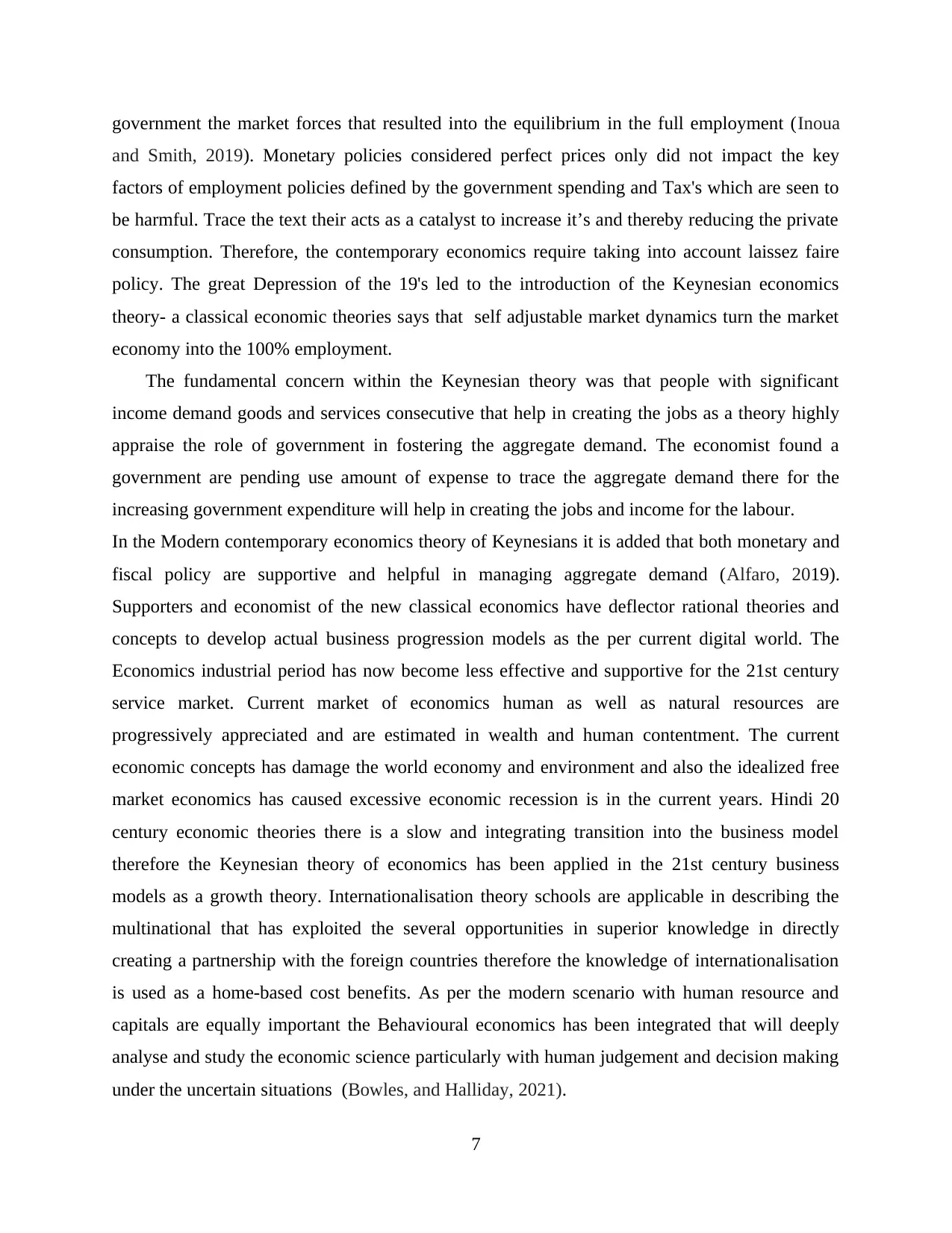
government the market forces that resulted into the equilibrium in the full employment (Inoua
and Smith, 2019). Monetary policies considered perfect prices only did not impact the key
factors of employment policies defined by the government spending and Tax's which are seen to
be harmful. Trace the text their acts as a catalyst to increase it’s and thereby reducing the private
consumption. Therefore, the contemporary economics require taking into account laissez faire
policy. The great Depression of the 19's led to the introduction of the Keynesian economics
theory- a classical economic theories says that self adjustable market dynamics turn the market
economy into the 100% employment.
The fundamental concern within the Keynesian theory was that people with significant
income demand goods and services consecutive that help in creating the jobs as a theory highly
appraise the role of government in fostering the aggregate demand. The economist found a
government are pending use amount of expense to trace the aggregate demand there for the
increasing government expenditure will help in creating the jobs and income for the labour.
In the Modern contemporary economics theory of Keynesians it is added that both monetary and
fiscal policy are supportive and helpful in managing aggregate demand (Alfaro, 2019).
Supporters and economist of the new classical economics have deflector rational theories and
concepts to develop actual business progression models as the per current digital world. The
Economics industrial period has now become less effective and supportive for the 21st century
service market. Current market of economics human as well as natural resources are
progressively appreciated and are estimated in wealth and human contentment. The current
economic concepts has damage the world economy and environment and also the idealized free
market economics has caused excessive economic recession is in the current years. Hindi 20
century economic theories there is a slow and integrating transition into the business model
therefore the Keynesian theory of economics has been applied in the 21st century business
models as a growth theory. Internationalisation theory schools are applicable in describing the
multinational that has exploited the several opportunities in superior knowledge in directly
creating a partnership with the foreign countries therefore the knowledge of internationalisation
is used as a home-based cost benefits. As per the modern scenario with human resource and
capitals are equally important the Behavioural economics has been integrated that will deeply
analyse and study the economic science particularly with human judgement and decision making
under the uncertain situations (Bowles, and Halliday, 2021).
7
and Smith, 2019). Monetary policies considered perfect prices only did not impact the key
factors of employment policies defined by the government spending and Tax's which are seen to
be harmful. Trace the text their acts as a catalyst to increase it’s and thereby reducing the private
consumption. Therefore, the contemporary economics require taking into account laissez faire
policy. The great Depression of the 19's led to the introduction of the Keynesian economics
theory- a classical economic theories says that self adjustable market dynamics turn the market
economy into the 100% employment.
The fundamental concern within the Keynesian theory was that people with significant
income demand goods and services consecutive that help in creating the jobs as a theory highly
appraise the role of government in fostering the aggregate demand. The economist found a
government are pending use amount of expense to trace the aggregate demand there for the
increasing government expenditure will help in creating the jobs and income for the labour.
In the Modern contemporary economics theory of Keynesians it is added that both monetary and
fiscal policy are supportive and helpful in managing aggregate demand (Alfaro, 2019).
Supporters and economist of the new classical economics have deflector rational theories and
concepts to develop actual business progression models as the per current digital world. The
Economics industrial period has now become less effective and supportive for the 21st century
service market. Current market of economics human as well as natural resources are
progressively appreciated and are estimated in wealth and human contentment. The current
economic concepts has damage the world economy and environment and also the idealized free
market economics has caused excessive economic recession is in the current years. Hindi 20
century economic theories there is a slow and integrating transition into the business model
therefore the Keynesian theory of economics has been applied in the 21st century business
models as a growth theory. Internationalisation theory schools are applicable in describing the
multinational that has exploited the several opportunities in superior knowledge in directly
creating a partnership with the foreign countries therefore the knowledge of internationalisation
is used as a home-based cost benefits. As per the modern scenario with human resource and
capitals are equally important the Behavioural economics has been integrated that will deeply
analyse and study the economic science particularly with human judgement and decision making
under the uncertain situations (Bowles, and Halliday, 2021).
7
⊘ This is a preview!⊘
Do you want full access?
Subscribe today to unlock all pages.

Trusted by 1+ million students worldwide
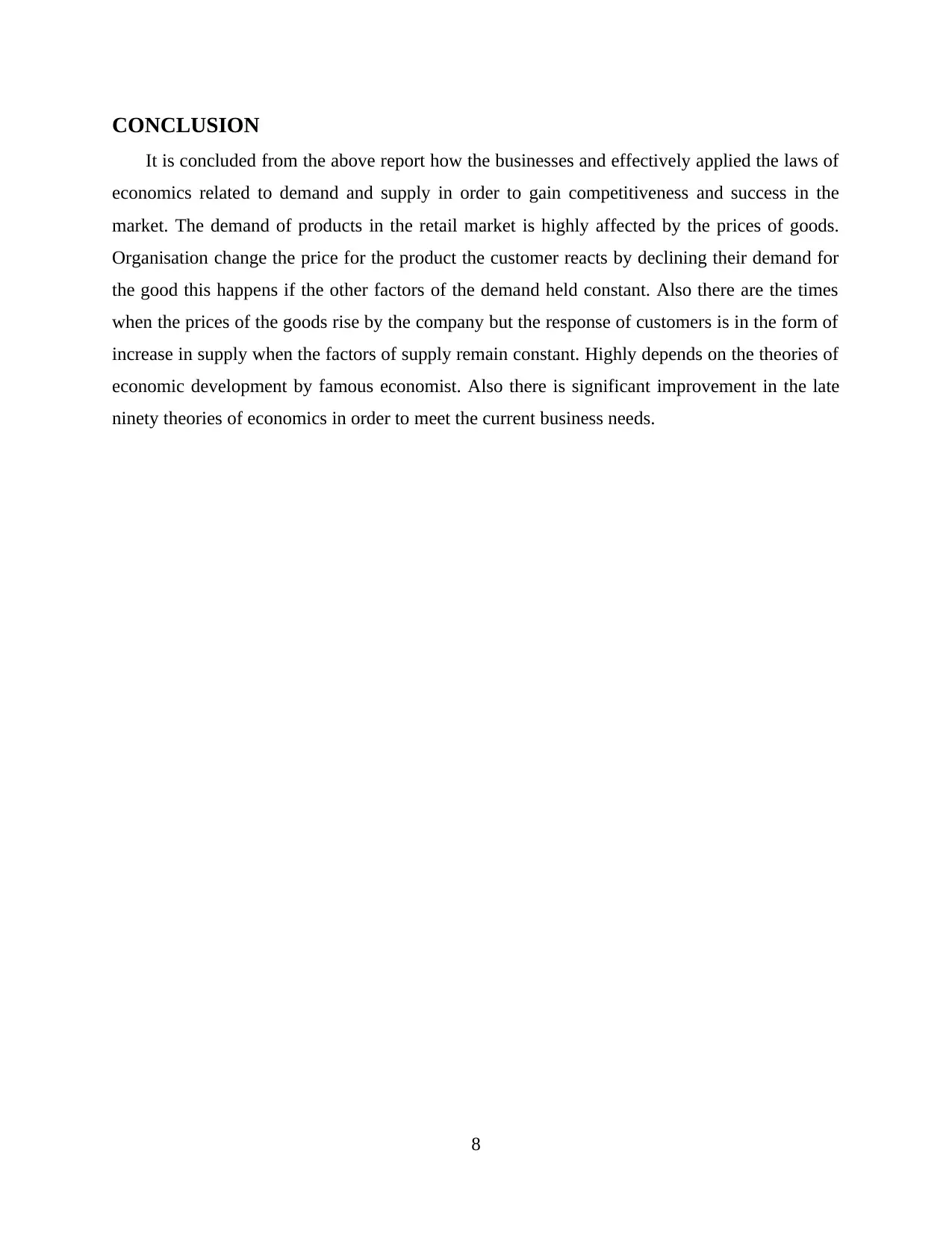
CONCLUSION
It is concluded from the above report how the businesses and effectively applied the laws of
economics related to demand and supply in order to gain competitiveness and success in the
market. The demand of products in the retail market is highly affected by the prices of goods.
Organisation change the price for the product the customer reacts by declining their demand for
the good this happens if the other factors of the demand held constant. Also there are the times
when the prices of the goods rise by the company but the response of customers is in the form of
increase in supply when the factors of supply remain constant. Highly depends on the theories of
economic development by famous economist. Also there is significant improvement in the late
ninety theories of economics in order to meet the current business needs.
8
It is concluded from the above report how the businesses and effectively applied the laws of
economics related to demand and supply in order to gain competitiveness and success in the
market. The demand of products in the retail market is highly affected by the prices of goods.
Organisation change the price for the product the customer reacts by declining their demand for
the good this happens if the other factors of the demand held constant. Also there are the times
when the prices of the goods rise by the company but the response of customers is in the form of
increase in supply when the factors of supply remain constant. Highly depends on the theories of
economic development by famous economist. Also there is significant improvement in the late
ninety theories of economics in order to meet the current business needs.
8
Paraphrase This Document
Need a fresh take? Get an instant paraphrase of this document with our AI Paraphraser
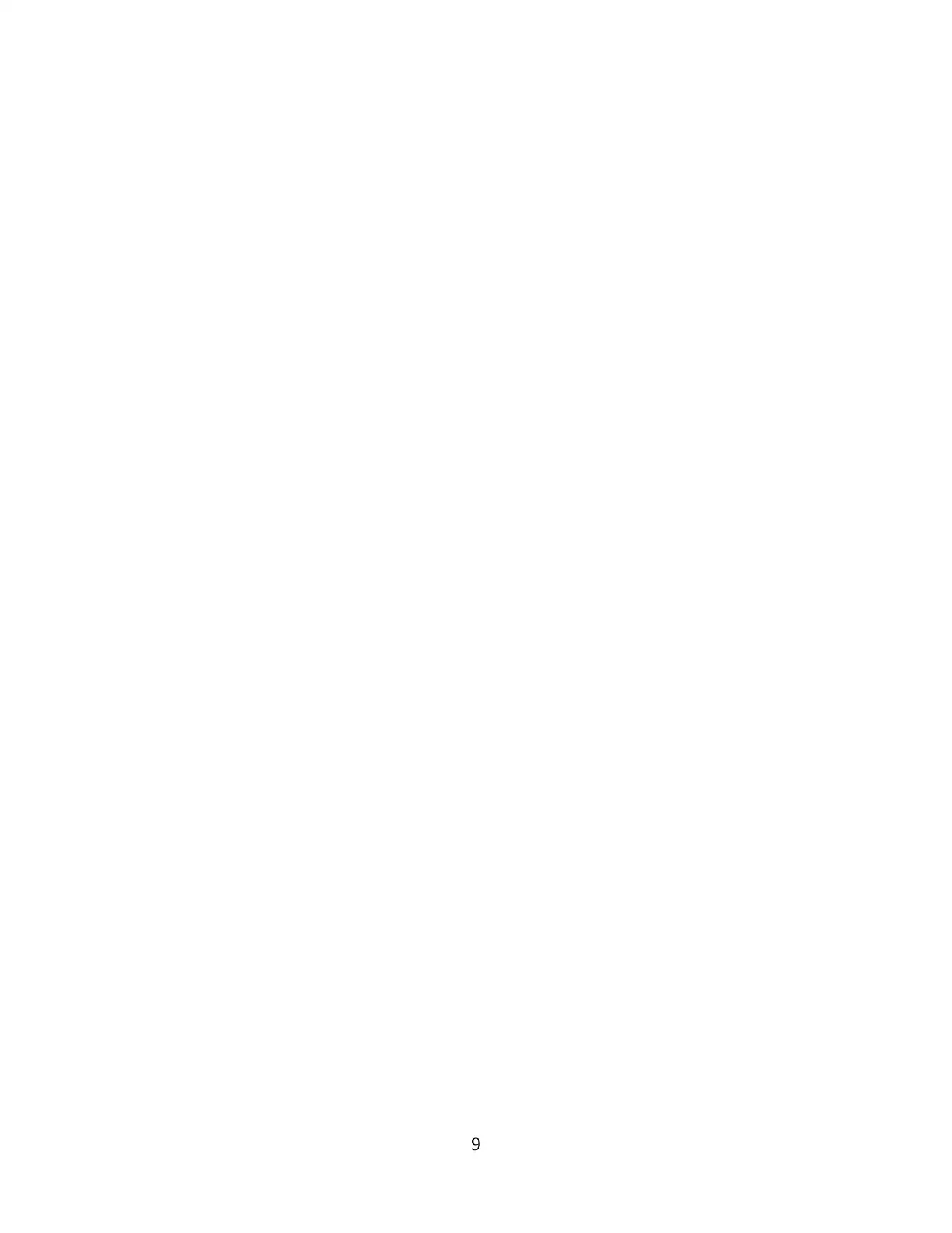
9
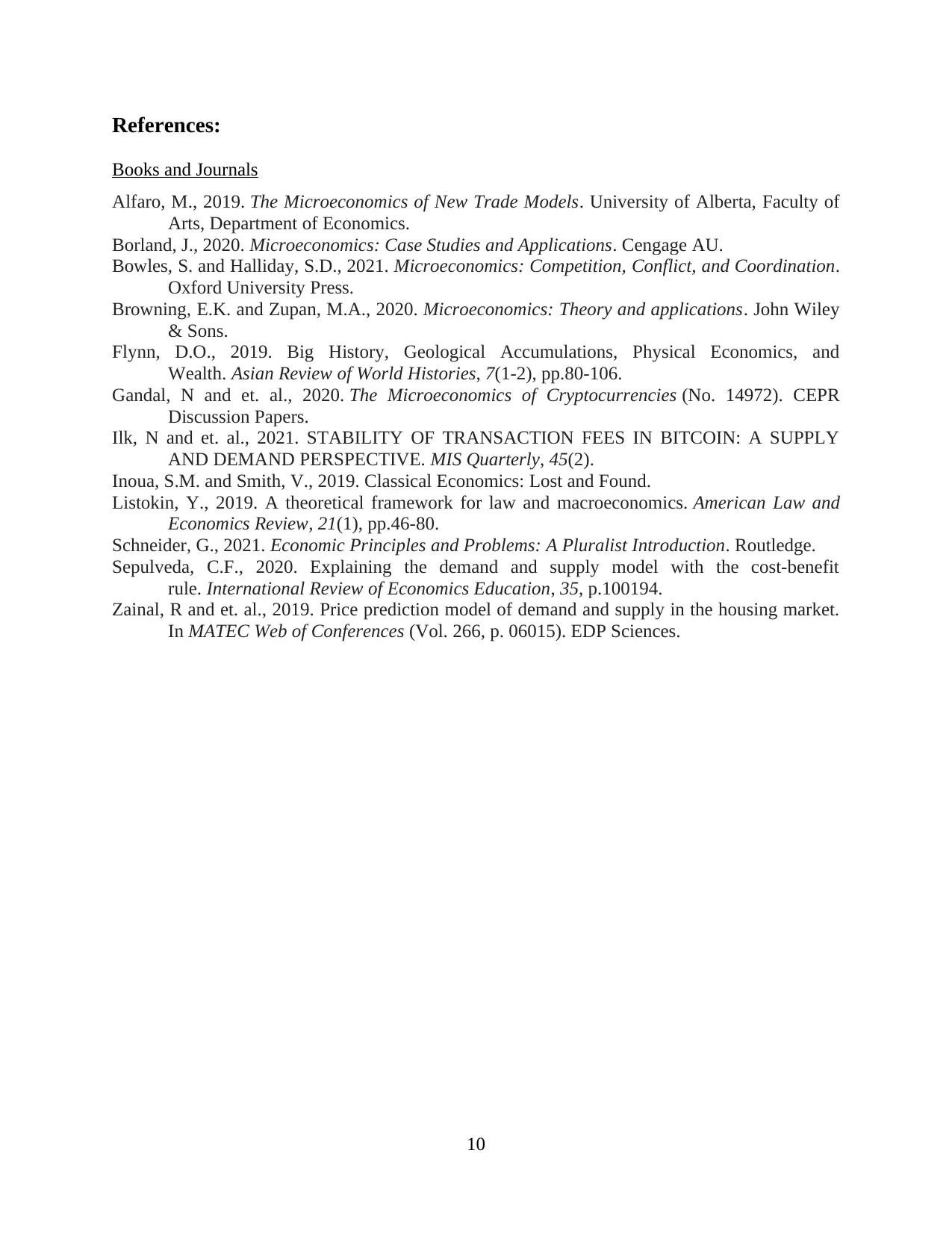
References:
Books and Journals
Alfaro, M., 2019. The Microeconomics of New Trade Models. University of Alberta, Faculty of
Arts, Department of Economics.
Borland, J., 2020. Microeconomics: Case Studies and Applications. Cengage AU.
Bowles, S. and Halliday, S.D., 2021. Microeconomics: Competition, Conflict, and Coordination.
Oxford University Press.
Browning, E.K. and Zupan, M.A., 2020. Microeconomics: Theory and applications. John Wiley
& Sons.
Flynn, D.O., 2019. Big History, Geological Accumulations, Physical Economics, and
Wealth. Asian Review of World Histories, 7(1-2), pp.80-106.
Gandal, N and et. al., 2020. The Microeconomics of Cryptocurrencies (No. 14972). CEPR
Discussion Papers.
Ilk, N and et. al., 2021. STABILITY OF TRANSACTION FEES IN BITCOIN: A SUPPLY
AND DEMAND PERSPECTIVE. MIS Quarterly, 45(2).
Inoua, S.M. and Smith, V., 2019. Classical Economics: Lost and Found.
Listokin, Y., 2019. A theoretical framework for law and macroeconomics. American Law and
Economics Review, 21(1), pp.46-80.
Schneider, G., 2021. Economic Principles and Problems: A Pluralist Introduction. Routledge.
Sepulveda, C.F., 2020. Explaining the demand and supply model with the cost-benefit
rule. International Review of Economics Education, 35, p.100194.
Zainal, R and et. al., 2019. Price prediction model of demand and supply in the housing market.
In MATEC Web of Conferences (Vol. 266, p. 06015). EDP Sciences.
10
Books and Journals
Alfaro, M., 2019. The Microeconomics of New Trade Models. University of Alberta, Faculty of
Arts, Department of Economics.
Borland, J., 2020. Microeconomics: Case Studies and Applications. Cengage AU.
Bowles, S. and Halliday, S.D., 2021. Microeconomics: Competition, Conflict, and Coordination.
Oxford University Press.
Browning, E.K. and Zupan, M.A., 2020. Microeconomics: Theory and applications. John Wiley
& Sons.
Flynn, D.O., 2019. Big History, Geological Accumulations, Physical Economics, and
Wealth. Asian Review of World Histories, 7(1-2), pp.80-106.
Gandal, N and et. al., 2020. The Microeconomics of Cryptocurrencies (No. 14972). CEPR
Discussion Papers.
Ilk, N and et. al., 2021. STABILITY OF TRANSACTION FEES IN BITCOIN: A SUPPLY
AND DEMAND PERSPECTIVE. MIS Quarterly, 45(2).
Inoua, S.M. and Smith, V., 2019. Classical Economics: Lost and Found.
Listokin, Y., 2019. A theoretical framework for law and macroeconomics. American Law and
Economics Review, 21(1), pp.46-80.
Schneider, G., 2021. Economic Principles and Problems: A Pluralist Introduction. Routledge.
Sepulveda, C.F., 2020. Explaining the demand and supply model with the cost-benefit
rule. International Review of Economics Education, 35, p.100194.
Zainal, R and et. al., 2019. Price prediction model of demand and supply in the housing market.
In MATEC Web of Conferences (Vol. 266, p. 06015). EDP Sciences.
10
⊘ This is a preview!⊘
Do you want full access?
Subscribe today to unlock all pages.

Trusted by 1+ million students worldwide
1 out of 12
Related Documents
Your All-in-One AI-Powered Toolkit for Academic Success.
+13062052269
info@desklib.com
Available 24*7 on WhatsApp / Email
![[object Object]](/_next/static/media/star-bottom.7253800d.svg)
Unlock your academic potential
Copyright © 2020–2025 A2Z Services. All Rights Reserved. Developed and managed by ZUCOL.



